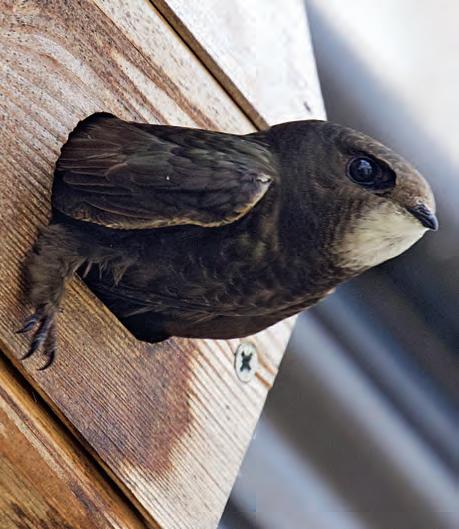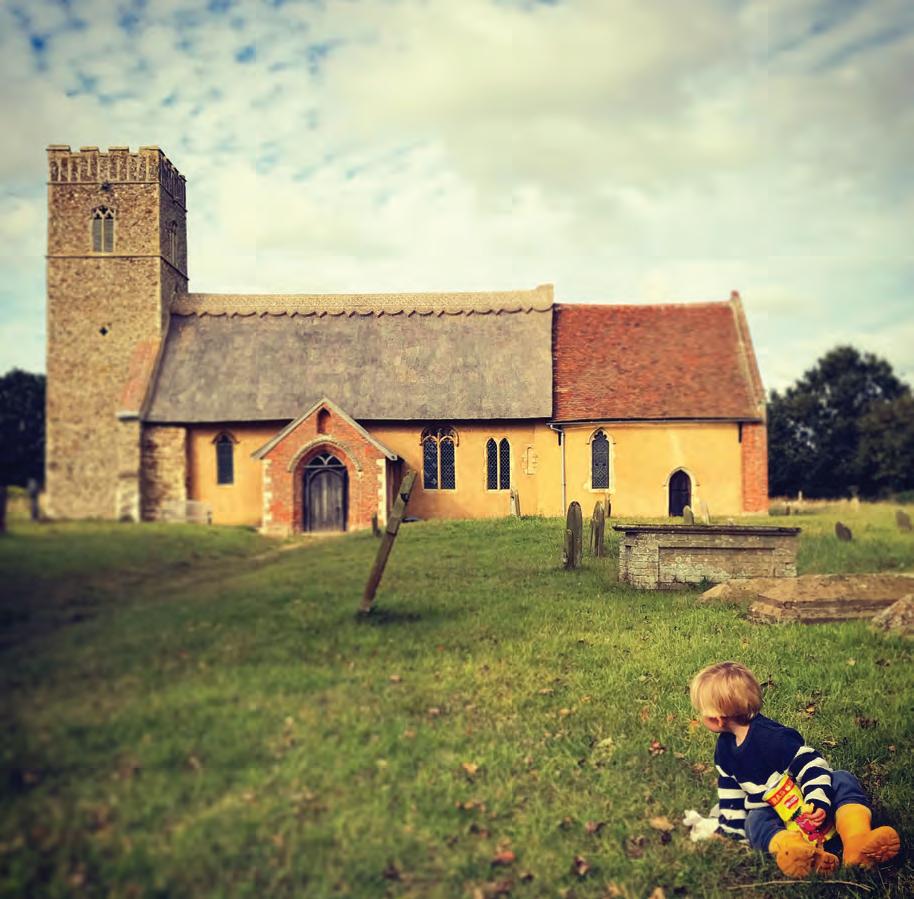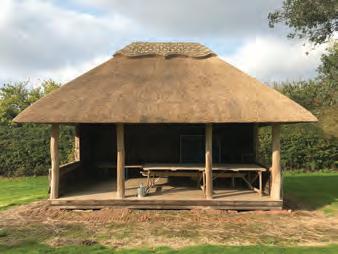
8 minute read
Flying High
Flying High As swifts return to our gardens in May, we need to take special care of these long distance visitors
Our skies will see the first swifts returning during the first week of May. While they only stay with us until August, these beautiful migratory birds are unfortunately making the headlines for all the wrong reasons. Jenny James of Woodbridge Swifts explains: “We’re faced with a national trend of declining numbers. We lost a further 32% of our swifts in the seven years from 2009 to 2016, with their numbers falling from 87,000 pairs to 59,000 pairs.
Advertisement
“Swifts pair for life, usually producing a single brood of two of three chicks each year” eddie bathgate , sos swi fts
“This means that we need to make a huge effort to conserve the swift nest sites across our region and to provide nest boxes to expand existing colonies.” Eddie Bathgate from SOS Swifts, which is part of the Suffolk Bird Group, says: “With their daring flying antics and lowlevel acrobatics, swifts feed, sleep and can even mate on the wing. Landing to fashion a minimal nest cup and breed, the adults taking turns to brood and feed their young. “Research has shown that breeding adults are extremely faithful to their nest sites, returning to them in early May, and juveniles are believed to follow the adult birds back to where they fledged, identifying their own site in year three prior to nesting in year four.
It is in year three that available nest sites, coupled with the attraction of swift calls, can be decisive. The birds are curious and will investigate possible sites, while screaming around in tight flocks at low level. Swifts pair for life, usually producing a single brood of two or three chicks each year and, if they survive their first year, can live to almost 20 years.”
Things we can do to help these most entertaining of summer visitors include:
l Put up a nest box or several nest boxes. l Use a CD player or Bluetooth speaker to play their calls out of the nearest window. Or buy a readymade swift call system with a speaker attached to the nest box. l Create groups of nest boxes around existing boxes and nesting sites so that a colony starts to build up.
Sadly, there are other problems for swifts. Eddie continues: “Insect numbers are generally in decline. In parts of East Anglia, with intense arable farming and use of herbicides and pesticides, there is less aerial plankton on which the swifts feed, so there’s fewer gnats, midges, small spiders and aphids, making these migratory birds more reliant on other, less nutritious insects such as hoverflies and lacewings to feed their young.”
Jenny adds: “Here in coastal Suffolk, we are lucky to have the estuaries of the Deben and the Alde, where there is more pasture and areas of uncultivated ground for insects to flourish.
“Like other migratory birds, swifts fly over many countries and climates. They need to synchronise their journeys with the seasonal cycles in southern Europe, the Mediterranean, and north, west and southern Africa. Climate change and human pressures are changing the environment in their winter homelands in ways we cannot predict and over which we have no control.”
The Suffolk Bird Group has set up a special project team: SOS Swifts. Working with Woodbridge Swifts, it is helping to raise awareness of the importance of encouraging these beautiful birds to return each summer.. Picture by Chris Courtney

l Details of nest boxes and swift call sound systems can be found at: www.rspb.org.uk/groups/woodbridge
l SOS Swifts can advise on all aspects of finding, monitoring and creating swift nest sites. Also pass on details of any nesting birds you observe via woodbridge.swifts@gmail.com or Swifts@SuffolkBirdGroup.org
l Woodbridge Swift Pint Walks. On Thursday, 2nd July and Saturday, 4th July, there’s an opportunity to walk around Woodbridge observing swifts in flight and entering their nest sites. Meeting at 7pm on Market Hill, there will also be an opportunity to compare notes in the pub afterwards. Main picture by Pawel Kuzniar

Learn to swim with us this year.
Give us a call for more information on our lessons.
suffolkcoastal.placesleisure.org
Visit website for full terms and conditions.
Places for People Leisure Ltd. working in partnership with East Suffolk Council.
One-to-One Training | Behaviour Modification | Product Sales

DOG ABOUT TOWN
Local home owners… throw open their doors Child free zones?… meet the couple with the Parent Pod! Is grey just so last year?… Jojo Humes Brown on colours
YOUR BRAND NEW FREE HOMES & LIFESTYLE MAGAZINE
“I’m known in these parts as Hector the Sausage, a friendly and very cute two-year-old miniature dachshund who lives in Suffolk Coastal with my humans. You might already know about me, as I’m what you may call a bit of a ‘celeb’! I have a staggering 45,000 people following my Instagram page @hectorthesausage, with fans from all over the world who enjoy seeing photos of my walks around Southwold, Aldeburgh and Sizewell beaches. I love nothing more than running on the sand, though I’m not quite brave enough to venture into the sea. Mum Laura is forever posting photos of me and has been ever since I was a little pup; my fame has even spawned a whole new business called www.hectorshoundwear.co.uk
I love being able to share my hometown of Southwold with hundreds of other sausage dogs when the fabulous Southwold Sausage Walk comes to the town, and I help promote that on my Instagram.
When I’m out and about, I regularly get spotted, which means I get lots of tickles from my adoring fans. I would most definitely prefer a treat over a tickle though! One of my favourite pastimes is popping into Two Magpies Bakery for a treat from the staff while my humans enjoy their coffee and cakes! Life is good.”
l Have you got a lovely dog and would like to give him/ her their 15 minutes of fame? Write to the team at info@livinginsuffolk.com and send us your best photos.
THE BUG H TEL Welcome bugs into your garden

Supplement increasing loss of natural habitats Encourage bene cial insects to help control pests Stimulate biodiversity Rusts with age and easy to ll and top up Two sizes available
For full details contact: 07909 544496 or email lynpeters225@gmail.com
T he D a y

Living In … meets Waldringfield-based thatcher James Stock and finds out more about this ancient craft
How did yo u get into thatchin g? Originally, I studied art but found it hard to make a living. After my studies, I did a fair bit of travelling and working abroad where I became interested in natural building methods. I was really drawn to cob buildings. So, when I returned to Suffolk, I decided I wanted to learn a traditional craft or trade, and to start making stuff again - to be creative! I just thought of thatching one day and decided to give it a try. That was back in 2011.
What is a nor ma l da y for a thatcher ? I don’t set an alarm because we have a baby and a toddler. Normally I get to site for 8am, and after that the day really does vary because there are so many different processes and materials involved and depends on whether we’re doing a long straw re-thatch to a ridge repair or a completely new water reed thatch. That’s the beauty of the trade, no job is ever the same. I normally finish up around 4.30pm.
D o yo u have to be accredited ? There is the East Anglian Master Thatches Association, which I am in the process of becoming a member.

Top: The church at Butley Left: James and his son, Sonny Above: Rethatched summer house at Butley Priory Below: The Ship at Levington
Where do yo ur materia ls co me fro m and how lon g sho uld a thatched roo f last ? We are lucky enough to have a good local supply of long straw which is grown in Parham near Framlingham. It’s grown and harvested in the traditional way specifically for thatching. There are also local suppliers of water reed, as well as imported reeds from Europe. I use a mixture of sawn ash and locally coppiced hazel for the ridge patterns.
A long straw roof should last around 35 years and a water reed at least 60- often more. However, the ridge will have to be replaced every 15 - 20 years.
D o yo u wor k with a tea m? Yes, I work with another thatcher - Jim Cutting - and we have taken on a labourer this year, who we can hopefully pass our knowledge on to.
How man y projects are yo u wor kin g on and how lon g is an avera ge jo b? It’s only one project at a time and the length of job really varies depending on what we’re doing – it could be two weeks or up to three months or more.
I s thatchin g a dyin g cra ft? There will always be a need for thatcher’s - but I do think more younger people need to be involved and should consider it as a career. There’s a lot of opportunity.
Based in Wa ldrin gfie ld, near Wood brid ge, how far do yo u trave l for wor k? I like to keep work as local as possible, and certainly within Suffolk!
What do yo u love most a bo ut yo ur jo b? The best thing is looking back at the finished product, knowing that you hand crafted the roof and it will be there for a long time to come. I take a lot of pride in that.

l You can contact James either by email: jamesdstock@yahoo.com or on his mobile, 07743 151841. Images of his work can be found on Instagram: jdstockthatching







